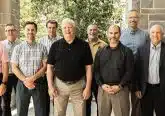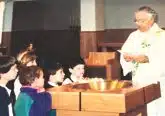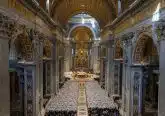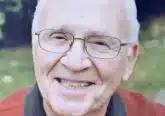First permanent deacons look back
By Walt Schaefer
Pope Paul VI took the first step in restoring the ancient order of permanent diaconate in the Catholic Church’s Latin Rite in 1967 as part of the Vatican II reforms. In the spring of 1968, the bishops of the United States petitioned the Holy Father to revive the diaconate in this country. For 50 years the permanent diaconate has grown and flourished, so that there are now more than 18,000 permanent deacons in the United States.
Like the first halting steps of an infant, the pioneers of the revived ministry found the early going quite different than the vibrant ministry of the new millennium.
Bill Brunsman, Fred Haas Jr., and Charley Jenkins set sail in 1976 on their mission to minister to the faithful of the Archdiocese of Cincinnati in the then-new role. They were among about 30 area men who embarked on a journey filled with ambiguity of purpose, contention, and even criticism. In 1976, the permanent diaconate was a nebulous calling, one that fostered concern among priests and lack of understanding among the laity.
Deacon Bill Brunsman
Since his ordination, Deacon Bill Brunsman, 82, has served at St. Mary Parish, Oxford; Queen of Peace Parish, Millville, and St Aloysius Parish, Shandon, where he remains active.
Deacon Brunsman, a retired General Electric engineer, said this of the early days of the diaconate: “Absolutely, we did not know what we were doing; the priests did not know what we were doing.
“There was a piece in ‘The Catholic Telegraph’ about this new program. My wife pointed it out to me. That afternoon, I rode my motorcycle to Mount St. Mary’s [then] in Norwood, and they had a two-hour exam including a stint with a psychologist. I remember a redheaded girl asking me what I thought of partial celibacy. I told her I didn’t know what she was talking about until she told me if my wife died I would not be able to marry again. I answered the questions off the top of my head. They told me: ‘Okay, you passed’ and I showed up in September to start it all.”
“I remember the pastor [at St. Mary’s in Oxford] was a German and a cantankerous guy. When it came time for my ordination, he called me in and said: “I do not like the idea of a diaconate; but I do like you.’”
The pastor told Deacon Brunsman: “‘I don’t know what to do with you, yet.’ So after ordination I did nothing from September until Thanksgiving – I sang in the choir; I ushered. Then, a friend of the pastor’s came in from out of town for Thanksgiving Mass and asked me to be deacon at the Mass. I said, ‘Sure.’”
Deacon Brunsman developed a talent for homilies and ran the RCIA program at Queen of Peace and St. Aloysius parishes. He serves on pastoral council and the worship commission at St. Aloysius.
Deacon Fred Haas, Jr.
Deacon Haas has served at St. Catharine Sienna Parish, Westwood; St. Ignatius of Loyola Parish, Monfort Heights; St. Leo the Great Parish, North Fairmount; St. Bonaventure Parish, South Fairmount; and St. Thomas More Parish, Withamsville, where he remains active.
“There was confusion from the start about what we could and couldn’t do,” said Deacon Haas, who taught religion at Bishop Fenwick High School, Middletown, and at Mother of Mercy and McAuley High Schools in Cincinnati.
“I remember a critical look from the priest like, ‘You’ve got to be kidding me.’”
When his class was sent off to minister following ordination, “we had different reactions,” he said. “Some of my classmates found themselves in good situations where they were welcome. Other classmates, and
I belong to this group, met pastors who said, ‘I don’t know what I’m going to do with you.’
“Some people in the parish were very supportive,” he said. “But others were like a deer in the headlights: ‘What’s this all about?’ They simply did not understand what the diaconate was all about. At the time people were talking about married clergy and we were often asked, ‘Do we have married clergy now?’ We said, ‘Yes.’”
Deacon Charley Jenkins
Deacon Jenkins has served at our Lady of Victory Parish throughout his ministry and was master of ceremonies for former Cincinnati Auxiliary Bishop James Garland.
Shortly after being introduced as one of Our Lady of Victory’s three new deacons, Deacon Jenkins was strolling through a shopping mall with his wife and three young daughters.
“Some people from the parish saw us at one of the stores and began saying, “Hi, Father, how are you?’ My antenna went up,” he said.
Deacon Jenkins also recalled the time in the mid-1970s when Father John Rae, who oversaw the first deacon program, was asked “if we could bless throats on the feast of St. Blaise, and distribute ashes on Ash Wednesday.
“Several parishes solicited transitional deacons, and we started asking Father Rae if we were going to do that kind of stuff. He said: ‘I don’t have the faintest idea.’ Nobody in this archdiocese knew exactly what the new deacons would be doing.”
Lay people at Our Lady of Victory soon became comfortable with the role of the permanent deacon, he said, but the priests were another story.
“You have to realize the archbishop, himself, didn’t realize what the deacons were going to do, either. It was brand new,” said Deacon Jenkins. Parish priests “did not want us on their turf,” he said.













